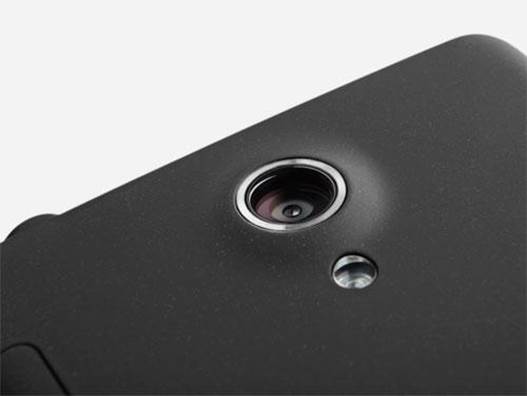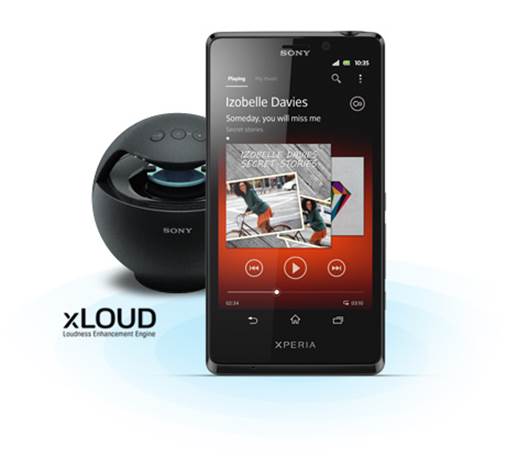The Xperia T runs Ice Cream Sandwich, with
an update to Jelly Bean promised for the first part of next year. Sony’s tweaks
to the user interface have always been among the more well considered, and
indeed some of the features it was first to introduce on its Gingerbread
devices, such as being able to create folders of apps simply by dragging one on
top of another, found their way into subsequent versions of the full OS.

The
Xperia T runs Ice Cream Sandwich, with an update to Jelly Bean promised for the
first part of next year.
It’s the same story here, with some
interesting ideas about enhancing the phone’s usability. Tap the multitasking
key, for instance, and you can not only switch between your running apps but
you can also access what Sony calls Small apps’. These simple, single function
apps such as a calculator or voice note recorder float on top of the screen and
then disappear when you no longer need them. It’s like a widget except you
don’t need to be looking at the home screen to use them. They will float above
any app.
Sony has also tied in the software with
some of its other brands. The Android music app is replaced with a Walkman app,
a simple but nicely styled audio player, and there are also wireless
connectivity options for your other Sony gear.
Sony manages to undo a lot of the good
things it does with its skin by overloading the phone with junk and bloatware.
Almost all of it can be uninstalled, but you shouldn’t really have to, Sony has
also tied in the software with some of its other brands. The Android music app
is replaced with a Walkman app, a simple but nicely styled audio player, and
there are also wireless connectivity options for your other Sony gear.
Sony manages to undo a lot of the good
things it does with its skin by overloading the phone with junk and bloat ware.
Almost all of it can be uninstalled, but you shouldn’t really have to,
especially when the apps offer so little value. So for example, you get
Widepilot. This is a satnav app, only you have to pay to unlock the satnav
part; otherwise it is basically an inferior of Google Maps. Along the same
lines there is OfficeSuite, but only for viewing (editing is a paid upgrade),
an EA games portal that offers you a few demos, a MacAfee security app and
Sony’s own content stores.
Video Unlimited is actually better in some
respects than Google’s Play Movies in the UK at least, as it offers TV
purchases, albeit the selection is very random so don’t count on your favourite
shows being there. Given that you cannot transfer this content to a non-Sony
device you may do better sticking with Google or side loading your own content,
however, unless you’re sure you’re going to be sticking with Sony next time
around as well.

The
Android music app is replaced with a Walkman app, a simple but nicely styled
audio player, and there are also wireless connectivity options for your other
Sony gear.
Music Unlimited is not so good. Tapping the
icon opens a page in the browser (you get both Chrome and the stock browser
installed) which then prompts you to download an app from the Play store, and
then sign up to a streaming service for $14.9 per month. It has a similar
feature set to Spotify, but if you don’t want to use it you cannot remove the
icon from your phone.
The other piece of software of note is
PlayStation Mobile. Again it is a separate download, and gives you access to
Sony’s new gaming portal: much hyped but very slow to take off. In its current
form it lacks recognisable content and the absence of free games will hardly
encourage people to try it out, but it’s one to keep an eye on.
Camera
The one area where Sony phones always excel
is the camera. On the Xperia T the camera has been upgraded to a huge 13
megapixels and produces shots of a quality as high as any other current Android
handset.
We love the presence of the dedicated
camera button on the side, as well as the fact that it can be used to take a
photo even when the phone is switched off and locked. No fiddling around with Lock
screens here, just hold down the camera key and the phone will wake up, the
camera app will launch and the snap will be taken all within the space of about
a second. It’s a fabulous trick, and yes the phone does remain locked to all
other tasks when you use it.
We’re not so keen on the fact that the
camera lens on the back is quite deeply recessed into the casing. The idea,
presumably, is to help protect it from bumps and scratches. Unfortunately
instead it merely serves as a home for dust and fluff that collects every time
you put the phone in your pocket and it’s very difficult to clean out properly.

On
the Xperia T the camera has been upgraded to a huge 13 megapixels and produces
shots of a quality as high as any other current Android handset.
The camera software is also pretty good,
although the default settings are confusing. By default the camera is set to
Scene Recognition mode, designed to automatically choose the required settings
based on the conditions you’re shooting in. It works up to a point and is tine
for those who merely want to point and shoot, but it hides all the manual
controls like ISO and metering settings and many users might never even know
that these settings exist.
Image quality is excellent, with the
inevitable drop off as the light dims. The slight stiffness of the shutter key
takes a few shots to get used to, but eventually you will feel handicapped
moving back to a phone that doesn’t have one. Video quality is also impressive,
aside from the sound of the autofocus motor, which is audible on recordings
made in very quiet conditions.
Hackabilify
The Xperia T has been rooted so you can
gain access to the various hacks and modifications that require root privileges
to power up the device. But Sony smartphones have never really captured the
imagination of the Android hacking community and there’s a real dearth of
custom ROMs and kernels for the phone.
Upgrading to Jelly Bean is possible, but if
you enjoy playing with and testing multiple ROMs then you will be disappointed
with the Xperia T.
Wrap up
In many respects the Sony Xperia T perfectly
reflects where Sony is as a smartphone manufacturer. The T is impressive, but
unexciting. It does what it does well, but it doesn’t do anything new. It is
the same story that we’ve seen throughout all the Xperia devices of at least
the last year and no doubt goes a long way towards explaining why the company
is continuing to find the Android market heavy going.

In
many respects the Sony Xperia T perfectly reflects where Sony is as a
srnartphone manufacturer.
There’s nothing much to dislike about the
Xperia T. Yes, its style is bland and the software is overloaded with junk, but
these are not major issues. The phone is fast, has decent quality and battery
life is just about on a par with your expectations. And the camera is
excellent. Just not so much more excellent than its rivals that you should
choose this over them.
As we head into 2013 the Xperia T still
feels very much like a 2012 phone. That’s fine if you aren’t concerned about
being at the bleeding edge of mobile technology. But if you do want to be sure
your phone will continue to compete right throughout the length of your
contract you might get greater reward from some of the other flagship devices
of the year instead.